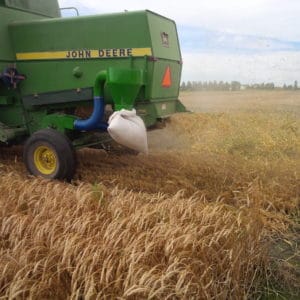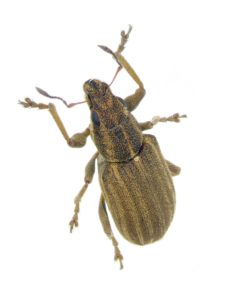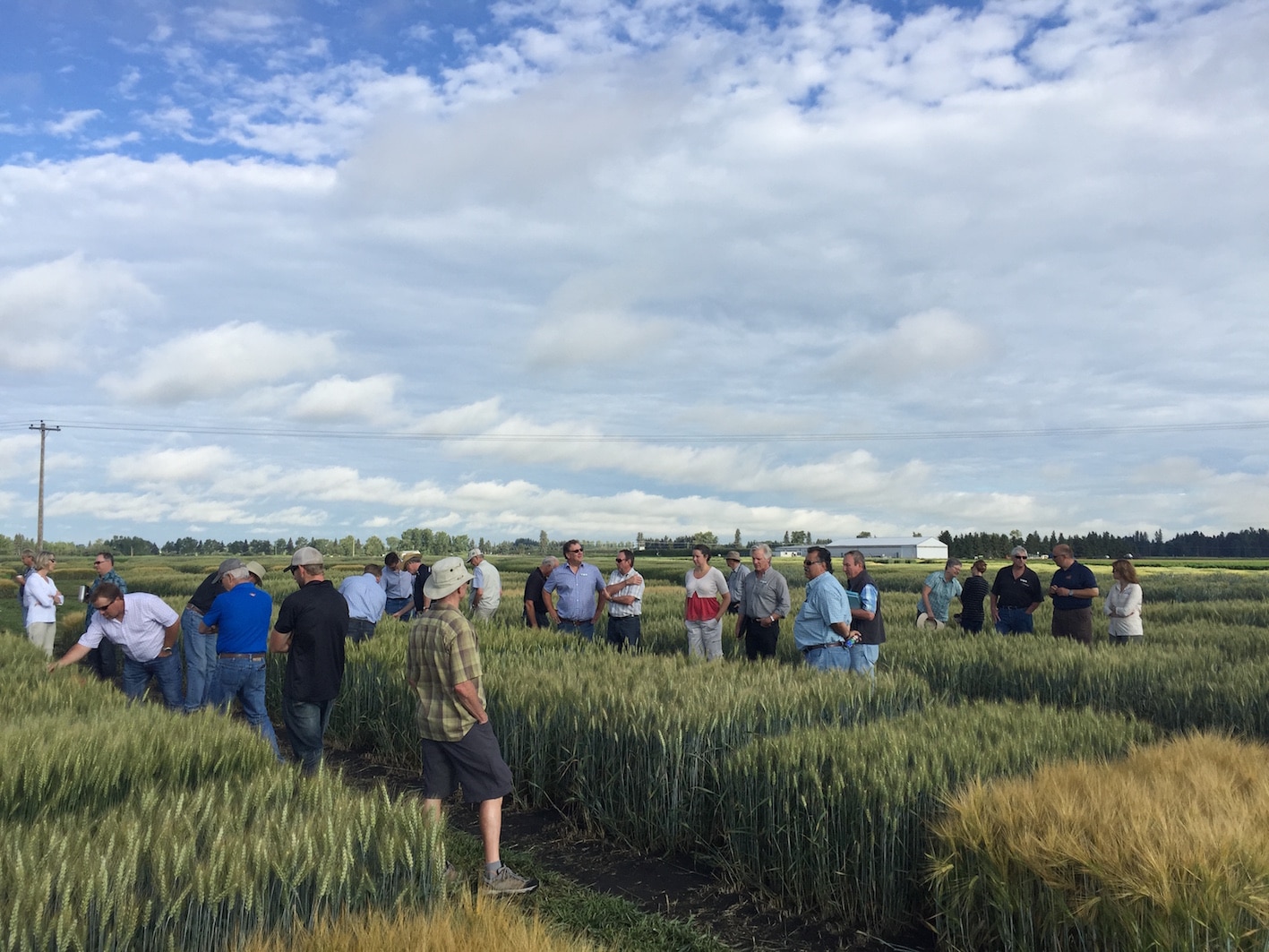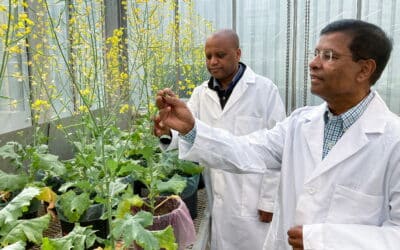WGRF’s funding is all about benefitting western Canadian crop growers.
Farmer-focused. Research-focused. Multi-crop. Interprovincial. Cross-cutting. Independent. Collaborative. Unique. That’s the Western Grains Research Foundation (WGRF). Building on more than 35 years of experience, this crop research funding agency is poised for the challenges ahead.
“We are a farmer-funded and farmer-directed organization. Our focus is on funding research; we’re not involved in policy or advocacy or market development. We’re an independent organization, and we’re incorporated as a non-profit charity, which makes us unique in Western Canada,” says Garth Patterson, WGRF executive director. “And our focus is interprovincial, looking at research that will benefit crop producers in Western Canada.”
Since its inception in 1981, WGRF has invested over $130 million into crop research. It is probably best known for its investment of wheat and barley check-offs into variety development.
“Through that investment, over 200 new wheat and barley varieties have been released since 1995,” notes Patterson. “We fund public crop breeding institutions and their varieties really dominate western Canadian acreage.” For instance, over 88 per cent of CWRS acres and 94 per cent of CWAD acres are seeded to WGRF-funded wheat varieties.
In addition, WGRF supports research projects on many field crops from its Endowment Fund. Patterson says, “We fund research into canola, wheat, pea, lentil, chickpea, dry bean, barley, corn, soy, canaryseed, flax, oats, even forages – you name it.”
Collaboration is key to WGRF’s approach to project funding. Patterson explains, “The benefits of research don’t stop at provincial borders, so we work with the organizations in Western Canada that are interested in crop research, including producer organizations, provincially based organizations and Agriculture and Agri-Food Canada (AAFC). Instead of running our own call for proposals, we consider the proposals that come in on their calls and look at ways to co-fund with them.”
According to Patterson, WGRF looks for three key elements in a research proposal. One is the potential to benefit crop producers in Western Canada. “That doesn’t mean we don’t invest in upstream research, but we want to have an understanding of how it might contribute in the end to profitability on the farm.” The other two elements are good science, and a strong likelihood that the researchers will accomplish the project’s objectives.
The WGRF’s research committee consists of experts representing various aspects of agriculture including: research, market development and agri-business; and WGRF board members. The research committee makes recommendations to the WGRF board of directors, which makes the final decisions on project funding. The board is composed of farmer representatives from each of the 18 member organizations, which include provincial, western Canadian and national farm organizations.
A Look at WGRF’s Latest Projects
WGRF funded over 20 new research projects in 2016 and is currently funding 250 projects. These projects cover an amazing array of topics such as: enhancing clubroot resistance in canola; improving faba bean, pea and alfalfa varieties; screening and managing Fusarium head blight in cereals; investigating novel ways to tackle herbicide resistance; managing pea leaf weevil in faba bean and field pea; and optimizing fertilizer management in flax. Most projects are co-funded with other agencies, enhancing the impact of WGRF dollars.
AAFC research scientist Neil Harker is leading the new project on herbicide resistance. “Weed resistance to herbicides is increasing rapidly and jeopardizes important herbicide tools,” he says. “Cropping systems that effectively manage weeds with less herbicide applications are urgently required to decrease the selection for more herbicide resistance, and to provide management tools in the face of new resistance issues.”

A WGRF-funded project is testing chaff collection devices to remove harvested weed seeds, one of several methods to reduce the need for herbicides. (Photo: Neil Harker, AAFC)
This project involves developing integrated weed management (IWM) strategies that reduce selection pressure for herbicide resistance. Harker explains: “In this project, we combine chaff collection (to remove harvested weed seeds) with some of the best cultural weed management techniques – high seeding rates, winter cereal crops, early-cut silage, perennial forage – in canola-wheat and more innovative crop rotations. This five-year experiment (2016-2020) is being conducted at six western Canadian locations under direct-seeding conditions.” Weed control tools such as chaff collection have more subtle effects than herbicides and require multiple years to determine their impact.
This research will introduce crop growers to new IWM strategies that reduce herbicide use and herbicide resistance selection pressure. “Combining chaff collection with previously proven IWM tools provides an opportunity to decrease the reliance on herbicides. With many weed seeds passing through the combine in the chaff fraction, collection of the chaff prevents many of the seeds from supplementing the seed-bank, thereby reducing weed populations,” says Harker.
“Chaff collection has the potential to reduce populations of many grassy and broadleaf weed species, and in combination with other weed-suppressing agronomic practices, can preserve the efficacy of herbicides.”
In addition to WGRF funding, this project is supported by the Alberta Canola Producers Commission, Saskatchewan Wheat Development Commission (Sask Wheat) and Alberta Barley.
Another new WGRF project concerns the pea leaf weevil. Many pea growers in southern Alberta are all too familiar with the yield losses due to the pea leaf weevil larvae feeding on pea root nodules and the adults feeding on pea foliage. Now this pest is spreading into new regions and a new host.
“The pea leaf weevil has recently expanded its geographic range to the Parkland agricultural regions in central Alberta and Saskatchewan where it threatens to damage

Funds from WGRF are helping researchers to assess ways to manage the pea leaf weevil in faba bean, another host for this pest. (Photo: Henri Goulet, AAFC-retired)
faba bean, in addition to peas,” says Héctor Cárcamo, a research scientist with AAFC who is the project’s principal investigator. “This project aims to learn more about the interaction between the pea leaf weevil and faba beans to determine if the weevil reduces yield in this crop and to assess potential management strategies. Another major objective is to improve our knowledge of the overwintering biology of this pest to enhance our ability to forecast local populations.”
This research will help faba bean growers determine if the weevil is a concern and how to manage it. “Faba bean is the best crop for nitrogen fixation and it may be able to compensate for pea leaf weevil feeding on the foliage (expected) and the larval feeding on root nodules,” notes Cárcamo. “The study will also provide objective data on the potential yield benefits of using seed treatment and foliar insecticides for the pea leaf weevil. The information on overwintering could help refine forecasting tools so we all have a better idea of the size of weevil pest populations to expect given certain winter conditions.”
WGRF and the Alberta Pulse Growers are funding this project. The University of Alberta, Alberta Agriculture and Forestry, and especially AAFC are providing substantial in-kind support.
Fusarium head blight (FHB), one of the most important wheat diseases on the Prairies, is the focus of a new spring wheat project. FHB lowers yields and results in downgrading because the fungus can produce toxins that limit the grain’s use. Fungicides can suppress the disease, but they only give up to about 50 per cent control. So cultivar resistance is a very important tool.
Unfortunately no single gene confers strong resistance to FHB. Breeders have to bring in several resistance genes, and even then most wheat varieties are only moderately resistant at best. So Randy Kutcher, an associate professor at the University of Saskatchewan, is working with AAFC’s Plant Gene Resources of Canada and the National Research Council to find new sources of FHB resistance in spring wheat. These three agencies are part of the Canadian Wheat Alliance, a partnership to develop new wheat varieties that produce stable and increased yields, and have stronger resistance to stresses including FHB.
The researchers are screening for FHB resistance in Plant Gene Resources’ 14,000 accessions of wheat collected from all over the world. “In a Fusarium head blight nursery, we screened about 4,000 lines in 2016 and we’ll do it again in 2017,” says Kutcher. “Then we’ll pick the most promising lines and rescreen them.” After that, they will do some further work with the best lines to confirm the resistance and to see how easy it would be to cross that resistance into adapted germplasm. They will pass along any useful new sources of FHB resistance to wheat breeders.
This project is supported by the Agriculture Development Fund of the Saskatchewan Ministry of Agriculture, Sask Wheat and WGRF.
Growth and Transition for WGRF
In 2016, WGRF invested over $19 million in breeding and other crop research, about a three-fold increase since 2011. WGRF has seen significant changes in its revenue sources over its history. It currently has five sources: the Endowment Fund, the wheat check-off, the barley check-off, royalties from commercialized wheat and barley varieties, and third-party funds to administer project funds (for example, WGRF is managing the funds awarded to projects in the Wheat Cluster under the Growing Forward 2 program).
The Endowment Fund got its start in 1981. “At the time, the Prairie Farm Assistance Act [an early version of crop insurance] was wound down. It had $9 million that came from farmers, so the federal government put that into kick-starting the Endowment Fund to fund research in a wide variety of crops,” explains Patterson.
Then in 2000, the Endowment Fund got another important source of funds. “The federal government named WGRF as the recipient under the Canada Transportation Act with respect to the Rail Revenue Entitlement. Anytime the railways exceed that Entitlement, the amount they exceed it by is awarded to WGRF,” Patterson says. He adds, “It is bittersweet because it means farmers have been overcharged for grain transportation. On the other hand it would be administratively very complex and costly to try and return that to farmers, so the federal government decided to put the money into WGRF to benefit all farmers.”
Of the $19 million invested in research by WGRF in 2016, about $7.5 million was from the Endowment Fund.
WGRF began administering the wheat and barley check-offs for variety development in 1994. A 2012 return-on-investment study commissioned by WGRF found that, on average, for every check-off dollar invested in variety development, producers receive $20 in value for wheat and $7.50 for barley.
The current Western Wheat and Barley Check-off is a five-year measure put in place by the federal government on Aug. 1, 2012 with the ending of the Canadian Wheat Board’s monopoly. This transitional measure is intended to allow provincial wheat and barley commissions and associations to take responsibility for research and market development. Currently, funds from this check-off go to WGRF, the Canadian International Grains Institute and the Canadian Malting Barley Technical Centre.
Patterson notes, “The western Canadian wheat and barley commissions and associations are making plans to assume the check-off starting on Aug. 1, 2017. Farmers really won’t notice a difference.”
WGRF felt it was crucial to prevent any funding gaps in wheat and barley variety development programs, so it has taken steps to ensure a smooth transition. “Even though the check-off that we receive expires on July 31, 2017, we had enough in our wheat and barley reserve funds to commit to new agreements that go to 2020 with the public institutions,” Patterson states.
“So there is stability for public breeders. And the wheat and barley commissions have time to put their plan together for how they would like to continue that.”
Renewing Agronomic Research Capacity
One of WGRF’s current initiatives involves reinvigorating agronomic research capacity in Western Canada. This initiative had its beginnings about three years ago, when a number of producer groups expressed concerns about declining capacity to WGRF.
To get a better handle on the issue, WGRF commissioned a study of the current and projected agronomic research capacity to 2020. The resulting report, Fertile Ground: Agronomic Research Capacity in Western Canada, was released in 2014. It confirmed the declining capacity, including loss of scientific expertise due to retirements, a lack of adequate equipment, land and buildings, and insufficient staff and funding.
So WGRF set up a technical committee to develop a vision of future agronomic research capacity, and it held a workshop in April 2015 to consult with stakeholders. This generated Shaping the Future, a report on ways to address the capacity needs.
Next, WGRF developed a two-phase strategy for reinvigorating agronomic research capacity. The strategy was finalized in spring 2016, and phase 1 is now being implemented.
Phase 1 involves rebuilding human resources research capacity at the main public institutions involved in agronomic research in Western Canada – AAFC, University of Alberta, University of Saskatchewan and University of Manitoba. AAFC has already started filling several positions, and WGRF is working with each of the three universities. Phase 2 will target capacity issues around infrastructure and equipment and at other research organizations. As the various capacity issues are addressed in phases 1 and 2, WGRF will be looking at how it can increase its agronomy-related project funding.
Where to From Here?
WGRF has built a strong tradition of supporting an impressive range of research, all targeted towards benefits to western Canadian crop producers. Researchers recognize WGRF’s valuable role. For instance, Kutcher says, “WGRF is a very important organization whose support is key to much of the field crop research in Western Canada.” And Cárcamo states, “The funding from WGRF is instrumental for crop researchers such as entomologists in Western Canada to allow us to continue to improve the economic and environmental sustainability of farming.”
What’s next for WGRF? “WGRF is in transition with the ending of the wheat and barley check-offs. But we’ve created a very stable situation as far as the support for wheat and barley variety development out to 2020. So, as we transition we are looking at what we can do in the Endowment Fund,” says Patterson.
“When we look at our strengths and our uniqueness, being western Canadian, multi-crop, farmer-focused and an independent charity, we think we can play a leadership role in cross-cutting issues.”
Many of today’s cross-cutting issues are vitally important to the success of crop production in Western Canada. Patterson highlights some examples: “Agronomy research capacity is one. We’ve also got issues related to climate change, whether it is crop adaptation to wetter, to drier, to warmer conditions. We’ve got the issue of what agriculture can do to mitigate climate change, for example by capturing carbon. We’ve got issues that cut across all crops like nutrient management, herbicide-resistant weeds and changing weed populations, and pest monitoring and management. And there are things like genomics capacity and tools that can benefit multiple crops.”
Harker notes, “It is crucial that agencies such as WGRF fund agronomic research that focuses on multiple crops. Growers do not grow a single crop on their farm. These projects provide growers with tools to manage challenges such as herbicide resistance in their entire crop rotation and not just in a single crop. In this regard, WGRF provides a unique service to growers when compared to individual crop funding agencies.”
Patterson emphasizes, “No other farm funding organization is focusing on a multi-crop, whole farm, integrated approach to western Canadian crop production. We think that is a very good role for WGRF to play moving forward.”





